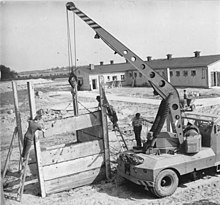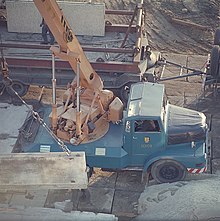Car slewing crane Panther

The Auto Crane Panther (ADK Panther) is in the GDR produced mobile crane . Although the development was based on the IFA H6 truck , the undercarriage was a new design and only some of the components of the standard vehicle were used. The crane was originally produced for loads up to five tons in the VEB Hebezeugwerk Sebnitz (types ADK I / 5 and ADK V / 5 ) and later improved to 6.3 tons (6.3 megapond ) (types ADK 63 and ADK 63-2 ) . In the later variants, the name Panther was no longer used, but was also colloquially transferred to these vehicles. Fire trucks were designated as KW 5 (crane truck 5).
The 5-tonne cranes developed from 1953 and built since 1954 were replaced in 1965 by the 6.3-tonne crane series, whose production ended in 1975. As a successor model, the ADK 70 with the IFA W50 as an undercarriage was manufactured since 1974 , which had a lower dead weight and a load capacity increased to 7 tons.
Parallel to the Panther, the Puma auto slewing crane for loads up to 3 tons was manufactured from 1957 to 1963 in the lower weight segment . In the next higher weight segment , the ADK 125 produced from 1971 for loads up to 12.5 tons was located.
history
Independently of the development of the Bleichert car slewing crane , the science department (WB) of the ABUS (work equipment for mining and heavy industry) in the Central Design Office (ZKB) in cooperation with the VEB Hebezeugwerk Sebnitz began to develop a slewing car crane in 1953 . During the Second World War, Sebnitz had experience with the licensed production of Bilstein cranes , and after the war they were able to gather brigade friends with the tractor slewing crane .
With the growing demand for mobile slewing cranes, attempts were first made to develop a crane that could easily be installed on standard truck chassis. The only type of IFA H6 available at the time was not suitable because of the lack of torsional rigidity of the frame and its insufficient payload.
ADK I / 5

One-man operation of the crane is from the driver's cab; in traffic the driver sits normally on the left-hand side, while the crane is operated from the passenger's side in the rear with a view of the turntable. In order to be able to move the vehicle in crane operation, it has a second set of pedals and a coupled double steering. To ensure a better view, the roof is sloped to the rear and glazed.
An axle lock can be used to create a rigid (unsprung) connection between frame and rear axle during crane operation. The crane can then be moved under load at 5 km / h. The lifting work is ideally carried out in a rearward direction with a deflection of up to 45 ° (from the center of the stern). Outside of this area, the load is shifted from the rear axle to the front axle, which can be prevented by lateral supports located between the axles below the turntable.
The crane was mainly used in non-stationary crane hook operation. The superstructure was firmly connected to the undercarriage via a slewing gear. The slewing gear and the lifting gear were operated electrically, the luffing gear via hydraulics. The diesel-electric drive made it possible to use the vehicle as a mobile emergency power unit with 18 kW and to operate the crane using external power. The swivel range was unlimited until 1956/57. The slip ring bodies, which were prone to wear and failure, then made it necessary to conduct electricity to the superstructure via a cable harness which, however, limited the swivel range to 340 °.
From 1955 the boom could be manually extended by 1.5 m.
For bulk movement, such as coal handling, the crane could order a gripper equipment are extended with an electrically operated motor grab. If the crane had the necessary extension, the gripper could be attached within minutes. Other possible attachments are a lifting magnet and a vacuum lifter .
By 1962, 858 ADK I / 5s had been manufactured in Sebnitz.
ADK I / 5 B
The ADK I / 5 B variant, manufactured from 1959 onwards, responded to the demands of the construction industry to produce a mobile tower crane. In order to also use the crane in building construction, a building crane component was developed. The lifting height increased to a maximum of 26 meters, the radius was up to 13 meters. The boom was automatically raised by the crane. During the transport, the boom was on a single-axis, steerable trailer. The total length of the vehicle combination was 22 m.
ADK V / 5
1960 began in Sebnitz with the further development of the ADK I / 5. Important changes were a more powerful engine and the single-plate dry clutch. 1180 units had been produced by 1965.
A plug-in boom with a load capacity of 0.9 t was introduced as new additional equipment. If the 1.5 meter long boom extension was exchanged for the plug-in boom, a lifting height of around 12 meters could be achieved. For road travel, the plug-in boom was folded back and the hook block attached to the counterweights at the rear.
ADK 6.3 and ADK 63
In 1965 production of the ADK 6.3 began, which received hydraulic power steering and an improved manual transmission. By revising the boom construction and equipping the boom extension with a pneumatic system, the load capacity could be increased to 6.3 t. The lifting speed in two- and three-leg operation has been increased by 35%. From 1968 a load torque protection (LMS) was installed as standard. Two years after its introduction, the vehicle has been marketed as ADK 63 since 1967.
As a result of an economic restructuring, VEB Hebezeugwerk Sebnitz was placed under the Progress Combine from 1970 . The crane production was relocated to VEB Schwermaschinenbau “Georgi Dimitroff” Magdeburg . 1692 units had been built by the end of production in 1970.
ADK 63-2
Production began in 1968 in the VEB Hebezeugwerk Sebnitz and was continued from 1971 in VEB Schwermaschinenbau "Georgi Dimitroff" Magdeburg-Buckau. The ADK 63-2 received a completely new crane structure. The boom is no longer stored directly on the turntable, but is located on a support frame. Two cylinders were used for rocking. The sensitivity of the slewing gear has been increased. The boom extension has been increased from 1.5 to 3 meters and can be extended hydraulically even under load. In addition to a more modern engine, the ADK 63-2 also had an engine brake. The axle lock could now be operated hydraulically from the cab for the first time. The driver's cab has also been redesigned and given new instrument panels. From 1969 to 1972 only 399 pieces were made.
ADK 63-1
The ADK 63-1 was built parallel to the ADK 63-2 and differs from it mainly in the mechanical telescoping of the boom. From 1971 to 1975, 890 units were built in Magdeburg.
Technical specifications
Many parts of the vehicles are standard components from vehicle production in the GDR. For example, components from the IFA H6 were used on the axles and brake system , while the engine from the IFA H3A (ADK I / 5), IFA S4000-1 (ADK V / 5, ADK 6.3) and later from the IFA W50 (ADK 63-2) came from.
The undercarriage could not be taken over from a production vehicle, it was made from an edged welded construction.
| ADK I / 5 | ADK V / 5 | ADK 63 | ADK 63-2 | |
|---|---|---|---|---|
| Engine ( four-cylinder 4- stroke diesel engine ) |
Type EM 4-15-1 | Type EM 4-22 / 90 | Type 4 VD 14.5 / 12-0 SRW (EM 4-22 / 90) |
Type 4 VD 14.5 / 12-1 SRW |
| Engine manufacturer | VEB Dieselmotorenwerk Schönebeck | IFA engine plant Nordhausen | ||
| Engine power | 44 kW (60 hp) at 1500 min -1 | 66.3 kW (90 PS) | 66.3 kW at 2000 min -1 | 66.2 kW at 2300 min -1 |
| Driving speed | 31.5 km / h | 42.2 km / h | 55.0 km / h | 57.5 km / h |
| Service weight net weight |
13,400 kg |
13,400 kg |
13,300 kg |
13,000 kg |
| Max. Load capacity | 5000 kg | 5000 kg | 6300 kg | 6300 kg |
| Lifting speed | 4.3 m / min | 7 m / min | 9.5 m / min (three fall) to 28.5 m / min (single fall) | |
| generator | 20 kVA, 400 V, 27 A | 30 kVA, 400 V, 44 A | ||
literature
- Walter Lütche: Giants of work - 40 years of mobile crane construction in the GDR. KM-Verlags GmbH, Griesheim 2003, ISBN 3-934518-05-2 .
- Ralf Christian Kunkel: GDR construction machinery 1945–1990. Motorbuchverlag, 2010, ISBN 978-3-613-03032-9 .




